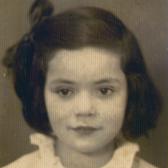
-
Learn More about Maryla
- Oral History Access Maryla's Oral Testimony
Maryla Korn was born Maryla Orgel on June 10, 1938, in Kraków, Poland, to Szymon Orgel and Felicia Muntz. Szymon was from a family of land and mill owners in Kolbuszowa, in southeastern Poland. Felicia came from an Orthodox family who owned shops in the main square of Kraków. They married in 1935 and soon settled in Kraków. Szymon often traveled to Kolbuszowa to help his family run their mills, while Felicia cared for Maryla.
Maryla was fifteen months old on September 1, 1939, when Germany invaded Poland and World War II began. Sensing danger, Maryla’s father and her grandfather, Bezalel Orgel, fled to the Polish city of Tarnopol (today: Ternopil’, Ukraine), which Soviet troops occupied in mid-September, 1939, to wait out the war. Based on his experience in World War I, Bezalel had believed women and children would be safe at home.
After occupying Kraków, German authorities enacted anti-Jewish laws. They confiscated Jewish businesses and sold them to non-Jews. The Muntz family’s employee, Juzek Siwetski, took over their shops for safe keeping. Only weeks after Germany invaded Poland, Felicia and Maryla were evicted from their apartment. Fearing the creation of a ghetto in Kraków, the Muntz family fled twenty miles east to Bochnia, Poland. There they rented two rooms and a kitchen from the Hojniks, a non-Jewish family living on the outskirts of town. On several occasions the Hojniks helped hide Maryla during round ups conducted by the Germans and their collaborators. In one instance, Maryla spent a day hiding in nearby fields with one of the Hojnik daughters.
On March 16, 1942, Nazi authorities forced Maryla and her family to move into the Bochnia ghetto. Felicia was assigned to work in a shopping bag factory, where she received meager rations. After establishing and sealing off a ghetto in spring 1942, the Germans began to remove Jews for incarceration in forced labor camps on April 16. Fearing increasing danger as Jews were being deported to forced labor and killing centers, Felicia obtained papers stating they were Christians.
Maryla and her mother, along with twenty other people, were smuggled out of the ghetto through a hole in the fence by an underground Jewish rescue organization. Walking by night and seeking shelter during the day, the escapees crossed the Carpathian Mountains into Slovakia. Despite their efforts to hide, Slovak authorities detained and imprisoned them. A rescue organization assisted in their release and refuge in Uszód, southern Hungary, where Felicia found work on a farm. When Germany occupied Hungary on March 19, 1944, Felicia and Maryla were on the run once again. They reached Bucharest, the capital of Romania, and were living there in late August, when King Michael and Romanian opposition leaders overthrew dictator Ion Antonescu. The new government changed their allegiance, and the Romanian Army fought alongside Soviet troops and invaded Hungary. The immediate danger was over.
After the war, Maryla and her mother settled in Brussels, Belgium, where Maryla attended school. In 1953, Maryla’s father joined them. Szymon had been deported to a Soviet prison camp in Siberia. In 1959, Maryla moved to Israel. During a visit to Brussels in 1961, Maryla met David Korn, who she married three months later. Maryla relocated to the United States, where she began work as the program director of the Jewish Student Association at Georgetown University in Washington, DC. Maryla and David have two children. Today, Maryla volunteers at the Museum.
